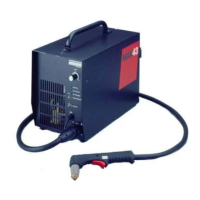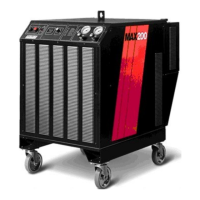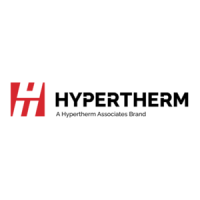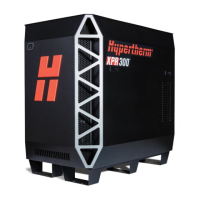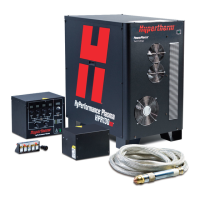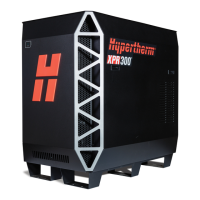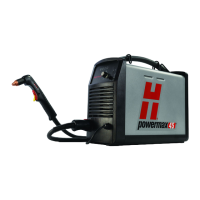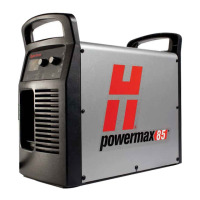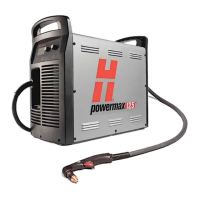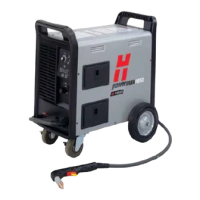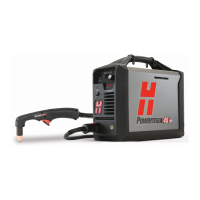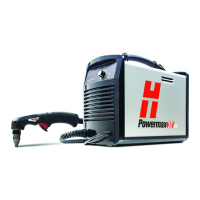Do you have a question about the Hypertherm MAXPRO200 and is the answer not in the manual?
Understand potential hazards and follow related instructions to avoid them.
Read all safety messages and labels. Keep labels in good condition. Learn operation.
Hazards associated with electrical shock and proper precautions.
Precautions for high voltage operation including insulated gear and proper grounding.
Prevention and explosion prevention measures related to cutting operations.
Hazards of toxic fumes and methods to reduce exposure.
Attaching work cable securely and connecting work table to earth ground.
Precautions for handling printed circuit boards to prevent static damage.
Safety guidelines for handling compressed gas cylinders and equipment.
Hazards associated with high-pressure gas cylinders and precautions.
Hazards of plasma arc exposure and protective measures.
Eye and skin protection from plasma arc rays, including shade recommendations.
Effects of magnetic fields on pacemakers and hearing aids.
Risks of hearing damage from plasma arc noise and protection measures.
Warning about thawing frozen pipes with a plasma torch.
Information on potential explosion hazards from dry dust collection systems.
Exposure to laser output can cause serious eye injury. Avoid direct eye exposure.
Explanation of various safety symbols and markings on the product.
References to relevant safety standards and regulations for welding and cutting.
Understanding the intent of warning symbols on power supplies.
Compliance with EN60974-10 and installation for EMC.
User responsibility for installation and resolving disturbances.
Assessing potential electromagnetic problems in the surrounding area.
Strategies to reduce electromagnetic emissions, including mains supply.
Routine maintenance and avoiding modifications for EMC.
Positioning and maintaining cutting cables for EMC.
Bonding metallic components to reduce electrical noise.
Workpiece grounding for safety and emissions reduction.
Selective screening and shielding of cables and equipment for interference reduction.
Use of genuine Hypertherm parts and user responsibility for safe use.
Hypertherm's warranty coverage for products and limitations.
Hypertherm's commitment to defend against patent infringement suits.
Exclusion of incidental, consequential, and punitive damages.
Precedence of national/local codes over manual instructions.
Limitation of Hypertherm's liability to the amount paid for products.
Customer's responsibility to maintain adequate insurance coverage.
Conditions for transferring warranty rights to a successor.
Hypertherm's commitment to regulatory and environmental compliance.
Precedence of national/local safety regulations over manual instructions.
Identification and meaning of certification test marks.
Considerations for varying national standards and certifications.
Guidance on safe installation and use per IEC 60974-9.
Tests for periodic inspection and after repair per IEC 60974-4.
Requirements for personnel performing electrical safety tests.
Use and testing of RCDs for electrical safety in certain regions.
Considerations for integrating Hypertherm systems into higher-level systems.
Hypertherm's commitment to environmental compliance and supplier information.
Precedence of national/local environmental regulations over manual instructions.
Hypertherm's compliance with the EU Restriction of Hazardous Substances Directive.
Environmentally acceptable disposal of Hypertherm products.
Compliance with EU Waste Electrical and Electronic Equipment Directive.
Impact of REACH regulation on chemicals and SVHC.
Availability of Material Safety Data Sheets (MSDS) for chemicals.
Information on air quality and fume analysis methods.
General overview of the MAXPRO200 plasma system.
Details of the 200 A, 165 VDC constant-current power supply.
Function and operation of the ignition console for pilot arc.
Maximum cutting and pierce capacities for MAXPRO200 torch.
Management of gas pressure and timing for the torch.
Liquid-to-air cooled heat exchanger and pump for coolant circulation.
Gas quality, pressure, and flow rate requirements.
Technical details of the power supply, including voltage and current ratings.
Dimensions and bend radius for straight torch.
Dimensions and bend radius for quick-disconnect torch.
Dimensions and bend radius for 90-degree hand torch.
Dimensions and bend radius for 65-degree hand torch.
Verifying component receipt and inspecting for shipping damage.
Procedures for filing claims for shipping damage or missing merchandise.
Conforming to national/local codes for electrical and plumbing.
Acceptable noise levels and recommended ear protection.
Guidelines for positioning components and tightening connections.
Practices for grounding and shielding to protect against RFI/EMI.
Guidelines for positioning the power supply for ventilation and service.
Connecting the torch lead to the ignition enclosure and CPC receptacle.
Connecting the work lead terminal to the work lead.
Connecting torch main body to torch leads.
Aligning and connecting the torch body to the quick-disconnect receptacle.
Installing the torch in the mounting bracket and aligning it.
Details on part numbers, lengths, and wiring for CNC interface cables.
Connecting a remote ON/OFF switch to the power supply control board.
Equipment compliance and recommendations for switches, fuses, and cables.
Function and installation of the supply-voltage disconnecting switch.
Selecting and installing the main power cable for the unit.
Connecting power cable to strain relief, ground connector, and contactor.
Coolant types, warnings, and precautions for the torch coolant system.
Mixing guidelines for coolant at cold temperatures.
Using treated water for coolant at hot operating temperatures.
Specifications for water purity in custom coolant mixes.
Steps for filling the power supply coolant tank and checking flow.
Connecting air, N2/N2, and O2/Air supply hoses.
System configuration for air/air cutting and gas connection changes.
Procedure for setting supply gas regulator pressures.
Selecting and using high-quality gas regulators for oxygen.
Guidelines for rigid copper plumbing or flexible hose for gas supplies.
Part numbers for air, oxygen, and nitrogen supply hoses.
Pre-operation checks, safety review, and consumables inspection.
Description of controls and indicators on the power supply unit.
System tests, power indicators, and display functions.
Explanation of display icons, amperage adjustment, and fault codes.
Setting amperage, plasma gas, and shield gas for cutting.
Specifications and consumables for handheld cutting.
Selecting consumables and gas settings for cutting.
Procedure for starting a cut from the workpiece edge or piercing.
Procedure for piercing the workpiece before cutting.
Specifications and safety precautions for gouging operations.
Essential protective gear and precautions for gouging.
Steps for performing a gouge on a workpiece.
Techniques for straight and weaving gouging.
Techniques for side and weaving gouging.
Typical gouge profiles and metal removal rates for different conditions.
How to adjust gouge profile by varying speed, standoff, and current.
Consumables, speeds, and settings for cutting processes.
Consumable parts specific to mechanized torches.
Consumables for handheld torches for cutting and gouging.
Selection of consumables for handheld torches by material and amperage.
Procedure for installing and inspecting torch consumables.
Steps for installing electrode, swirl ring, nozzle, and shield.
Guidelines for inspecting shield, nozzle retaining cap, nozzle, swirl ring, and electrode.
Routine maintenance and quick-disconnect maintenance for the torch.
Connecting quick-disconnect and straight torches.
Procedure for replacing the torch water tube.
Troubleshooting common cutting faults for machine and hand torches.
Tips for achieving square, straight, smooth, and dross-free cuts.
Recommendations for table and torch setup for optimal cutting.
Follow daily start-up and purge gas lines before cutting.
Tips for extending consumable life with LongLife process.
Factors affecting cut quality, including cut angle.
Acceptable cut angles and troubleshooting cut angle problems.
Types of dross and methods to reduce their formation.
Achieving a straight cut surface by adjusting torch height.
Methods to increase cutting speed, with considerations for cut angle.
Charts for estimating kerf-width compensation for various materials.
Consumables, speeds, and settings for cutting processes.
Understand potential hazards and follow related instructions to avoid them.
Read all safety messages and labels. Keep labels in good condition. Learn operation.
Hazards associated with electrical shock and proper precautions.
Precautions for high voltage operation including insulated gear and proper grounding.
Prevention and explosion prevention measures related to cutting operations.
Hazards of toxic fumes and methods to reduce exposure.
Attaching work cable securely and connecting work table to earth ground.
Precautions for handling printed circuit boards to prevent static damage.
Safety guidelines for handling compressed gas cylinders and equipment.
Hazards associated with high-pressure gas cylinders and precautions.
Hazards of plasma arc exposure and protective measures.
Eye and skin protection from plasma arc rays, including shade recommendations.
Effects of magnetic fields on pacemakers and hearing aids.
Risks of hearing damage from plasma arc noise and protection measures.
Warning about thawing frozen pipes with a plasma torch.
Information on potential explosion hazards from dry dust collection systems.
Exposure to laser output can cause serious eye injury. Avoid direct eye exposure.
Explanation of various safety symbols and markings on the product.
References to relevant safety standards and regulations for welding and cutting.
Understanding the intent of warning symbols on power supplies.
Compliance with EN60974-10 and installation for EMC.
User responsibility for installation and resolving disturbances.
Assessing potential electromagnetic problems in the surrounding area.
Strategies to reduce electromagnetic emissions, including mains supply.
Routine maintenance and avoiding modifications for EMC.
Positioning and maintaining cutting cables for EMC.
Bonding metallic components to reduce electrical noise.
Workpiece grounding for safety and emissions reduction.
Selective screening and shielding of cables and equipment for interference reduction.
Use of genuine Hypertherm parts and user responsibility for safe use.
Hypertherm's warranty coverage for products and limitations.
Hypertherm's commitment to defend against patent infringement suits.
Exclusion of incidental, consequential, and punitive damages.
Precedence of national/local codes over manual instructions.
Limitation of Hypertherm's liability to the amount paid for products.
Customer's responsibility to maintain adequate insurance coverage.
Conditions for transferring warranty rights to a successor.
Hypertherm's commitment to regulatory and environmental compliance.
Precedence of national/local safety regulations over manual instructions.
Identification and meaning of certification test marks.
Considerations for varying national standards and certifications.
Guidance on safe installation and use per IEC 60974-9.
Tests for periodic inspection and after repair per IEC 60974-4.
Requirements for personnel performing electrical safety tests.
Use and testing of RCDs for electrical safety in certain regions.
Considerations for integrating Hypertherm systems into higher-level systems.
Hypertherm's commitment to environmental compliance and supplier information.
Precedence of national/local environmental regulations over manual instructions.
Hypertherm's compliance with the EU Restriction of Hazardous Substances Directive.
Environmentally acceptable disposal of Hypertherm products.
Compliance with EU Waste Electrical and Electronic Equipment Directive.
Impact of REACH regulation on chemicals and SVHC.
Availability of Material Safety Data Sheets (MSDS) for chemicals.
Information on air quality and fume analysis methods.
General overview of the MAXPRO200 plasma system.
Details of the 200 A, 165 VDC constant-current power supply.
Function and operation of the ignition console for pilot arc.
Maximum cutting and pierce capacities for MAXPRO200 torch.
Management of gas pressure and timing for the torch.
Liquid-to-air cooled heat exchanger and pump for coolant circulation.
Gas quality, pressure, and flow rate requirements.
Technical details of the power supply, including voltage and current ratings.
Dimensions and bend radius for straight torch.
Dimensions and bend radius for quick-disconnect torch.
Dimensions and bend radius for 90-degree hand torch.
Dimensions and bend radius for 65-degree hand torch.
Verifying component receipt and inspecting for shipping damage.
Procedures for filing claims for shipping damage or missing merchandise.
Conforming to national/local codes for electrical and plumbing.
Acceptable noise levels and recommended ear protection.
Guidelines for positioning components and tightening connections.
Practices for grounding and shielding to protect against RFI/EMI.
Guidelines for positioning the power supply for ventilation and service.
Connecting the torch lead to the ignition enclosure and CPC receptacle.
Connecting the work lead terminal to the work lead.
Connecting torch main body to torch leads.
Aligning and connecting the torch body to the quick-disconnect receptacle.
Installing the torch in the mounting bracket and aligning it.
Details on part numbers, lengths, and wiring for CNC interface cables.
Connecting a remote ON/OFF switch to the power supply control board.
Equipment compliance and recommendations for switches, fuses, and cables.
Function and installation of the supply-voltage disconnecting switch.
Selecting and installing the main power cable for the unit.
Connecting power cable to strain relief, ground connector, and contactor.
Coolant types, warnings, and precautions for the torch coolant system.
Mixing guidelines for coolant at cold temperatures.
Using treated water for coolant at hot operating temperatures.
Specifications for water purity in custom coolant mixes.
Steps for filling the power supply coolant tank and checking flow.
Connecting air, N2/N2, and O2/Air supply hoses.
System configuration for air/air cutting and gas connection changes.
Procedure for setting supply gas regulator pressures.
Selecting and using high-quality gas regulators for oxygen.
Guidelines for rigid copper plumbing or flexible hose for gas supplies.
Part numbers for air, oxygen, and nitrogen supply hoses.
Pre-operation checks, safety review, and consumables inspection.
Description of controls and indicators on the power supply unit.
System tests, power indicators, and display functions.
Explanation of display icons, amperage adjustment, and fault codes.
Setting amperage, plasma gas, and shield gas for cutting.
Specifications and consumables for handheld cutting.
Selecting consumables and gas settings for cutting.
Procedure for starting a cut from the workpiece edge or piercing.
Procedure for piercing the workpiece before cutting.
Specifications and safety precautions for gouging operations.
Essential protective gear and precautions for gouging.
Steps for performing a gouge on a workpiece.
Techniques for straight and weaving gouging.
Techniques for side and weaving gouging.
Typical gouge profiles and metal removal rates for different conditions.
How to adjust gouge profile by varying speed, standoff, and current.
Consumables, speeds, and settings for cutting processes.
Consumable parts specific to mechanized torches.
Consumables for handheld torches for cutting and gouging.
Selection of consumables for handheld torches by material and amperage.
Procedure for installing and inspecting torch consumables.
Steps for installing electrode, swirl ring, nozzle, and shield.
Guidelines for inspecting shield, nozzle retaining cap, nozzle, swirl ring, and electrode.
Routine maintenance and quick-disconnect maintenance for the torch.
Connecting quick-disconnect and straight torches.
Procedure for replacing the torch water tube.
Troubleshooting common cutting faults for machine and hand torches.
Tips for achieving square, straight, smooth, and dross-free cuts.
Recommendations for table and torch setup for optimal cutting.
Follow daily start-up and purge gas lines before cutting.
Tips for extending consumable life with LongLife process.
Factors affecting cut quality, including cut angle.
Acceptable cut angles and troubleshooting cut angle problems.
Types of dross and methods to reduce their formation.
Achieving a straight cut surface by adjusting torch height.
Methods to increase cutting speed, with considerations for cut angle.
Charts for estimating kerf-width compensation for various materials.
Consumables, speeds, and settings for cutting processes.
| Output Current | 200 A |
|---|---|
| Open Circuit Voltage (OCV) | 300 VDC |
| Duty Cycle | 100% @ 200 A |
| Efficiency | 85% |
| Rated Output | 200 A @ 100% duty cycle |
| Gas Supply | Air |
| Cutting Capacity (Mild Steel) - Severance | 50 mm (2") |
| Cutting Capacity (Mild Steel) - Production | 32 mm (1.25 in) |
| Cutting Capacity (Stainless Steel) - Severance | 38 mm (1.5 in) |
| Cutting Capacity (Stainless Steel) - Production | 25 mm (1") |
